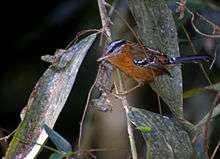Drymophila
| Drymophila | |
|---|---|
 | |
| Ferruginous antbird | |
| Scientific classification | |
| Kingdom: | Animalia |
| Phylum: | Chordata |
| Class: | Aves |
| Order: | Passeriformes |
| Family: | Thamnophilidae |
| Tribe: | Pithyini |
| Genus: | Drymophila Swainson, 1824 |
| Species | |
|
Drymophila caudata | |
Drymophila is a bird genus in the antbird family (Thamnophilidae). It is a relative of the typical antwrens.
Species
- Ferruginous antbird, Drymophila ferruginea
- Bertoni's antbird, Drymophila rubricollis
- Rufous-tailed antbird, Drymophila genei
- Ochre-rumped antbird, Drymophila ochropyga
- Striated antbird, Drymophila devillei
- Dusky-tailed antbird, Drymophila malura
- East Andean antbird, Drymophila caudata
- Klages's antbird, Drymophila klagesi
- Santa Marta antbird, Drymophila hellmayri
- Streak-headed antbird, Drymophila striaticeps
- Scaled antbird, Drymophila squamata
Range
Six of the Drymophila species are associated with regions of southeastern Brazil; two of these - Bertoni's and dusky-tailed antbird - also range into eastern Paraguay and extreme northeastern Argentina.
Even at their highest diversity in Brazil's Mata Atlântica, the species are almost completely parapatric, in some cases like the dusky-tailed and scaled antbird even to exclusive habitat preferences. Of course, the rampant deforestation in that region may obscure that there has been more overlap in the past. In any case, habitat fragments strongly tend to hold at most a single species.[1]
D. devillei, the striated antbird, is a species of the southwestern quadrant of the Amazon Basin, and a disjunct population lives in north-western Ecuador and adjacent parts of Colombia.
Footnotes
- ↑ Rajão & Cerqueira (2006)
References
- Rajão, Henrique & Cerqueira, Rui (2006): Distribuição altitudinal e simpatria das aves do gênero Drymophila Swainson (Passeriformes, Thamnophilidae) na Mata Atlântica [Elevational distribution and sympatry of birds of the genus Drymophila Swainson (Passeriformes, Thamnophilidae) in the Atlantic forest]. [Portuguese with English abstract] Revista Brasileira de Zoologia 23(3): 597–607. doi:10.1590/S0101-81752006000300002 PDF fulltext